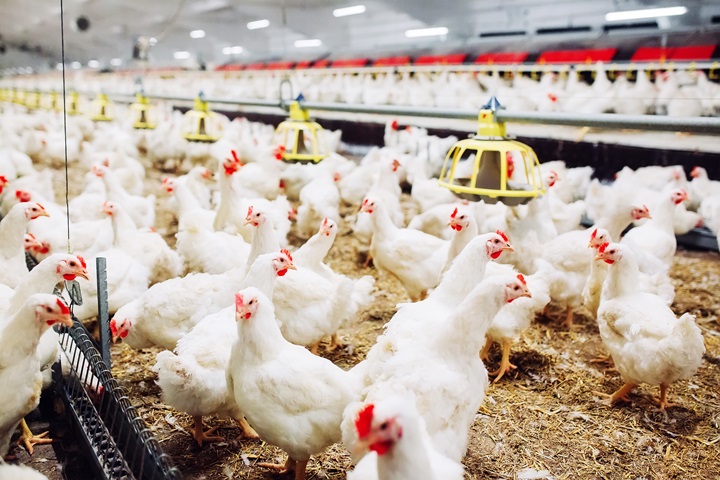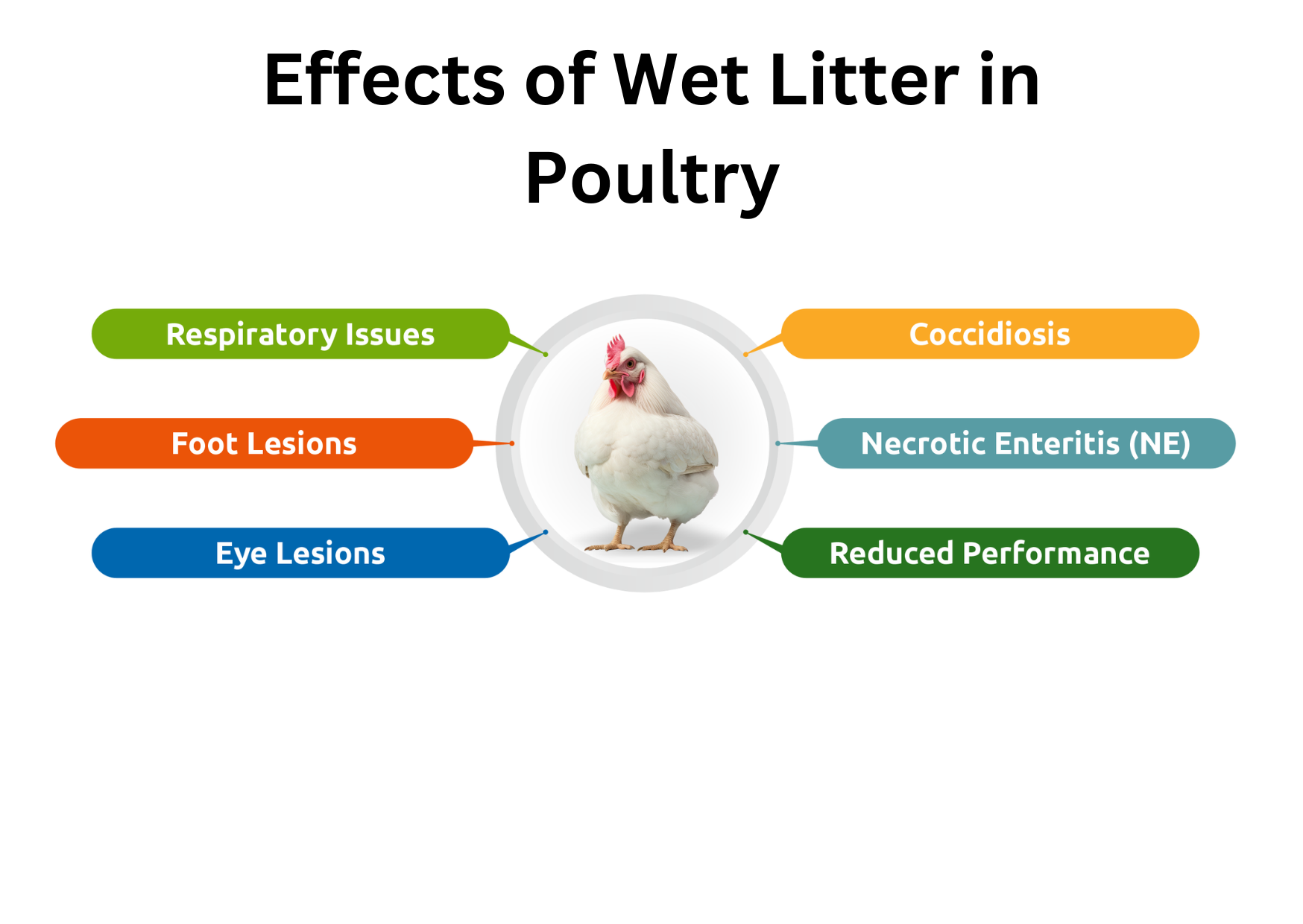
Poultry
Wet Litter Problem in Poultry: Causes & Prevention
To avoid distress among poultry birds, we must ensure that they are raised in a safe and healthy environment where their nutritional needs are met. One of the biggest challenges the poultry industry faces is the wet litter problem in poultry. Wet litter in poultry can negatively impact your chickens’ health resulting in decreased production and increased mortality rates. Therefore, poultry litter management is necessary to ensure your chickens are thriving in a healthy condition.
Wet Litter in Poultry Meaning
Litter consists of manure mixed with bedding material. When the amount of spillage or excretion surpasses the evaporation rate, it becomes wet litter. To maintain the litter in a friable condition, it’s essential to monitor the heating and ventilation systems continuously.
As the moisture content accumulates and the litter is sealed, the birds grow on slippery, damp, and sticky surfaces. This sealed litter is referred to as being ‘caked’. In this situation, the murky water remains trapped within the litter and cannot escape. If the litter is not continuously monitored, wet litter problem in poultry arise, leading to increased bacteria, foul odors from higher ammonia levels, insect infestations, foot lesions in birds, and numerous other diseases. Therefore, litter management in poultry is crucial for a healthy environment.
Causes & Prevention for Wet Litter Problem in Poultry
There are several factors associated with wet litter problems in poultry, such as providing proper clean housing and monitoring the health and nutritional factors. Properly checking and implementing control measures can work wonders and prevent wet litter problem in poultry.
Proper litter management involves a few key steps. By monitoring these simple steps, you can ensure your birds thrive in a healthy environment.
Bedding Materials
Bedding materials used in broiler houses should have enough capacity to absorb water and should have reasonable drying rates. Using bedding materials with good litter friability and less susceptibility to cake formation and water activity are important factors to consider for preventing wet litter in poultry.
Additionally, the bedding materials used should be non-toxic for the birds. Soft-quality wood shavings are the go-to choice used by farmers as bedding material if the pricing is reasonable. On the other hand, straw, rice hulls, municipal garbage, and shredded cardboard do not provide qualitative results. These materials have lower absorption rates, and added manure and excretion lead to litter caking. Therefore, as part of poultry litter management, providing the correct bedding material is necessary.
Water Activity
Water activity (Aw) is a thermodynamic property indicating the relative availability or freedom of water within a material. It is widely regarded as more closely associated with the microbial, chemical, and physical properties of natural products than total moisture content, making it a potentially superior measure of litter quality. The detrimental effects of wet litter stem from either pathogenic organisms (like bacteria and fungi) or direct water contact, with Aw playing a direct role in these processes.
Ventilation
Temperature, airflow, and humidity are essential to managing wet litter in poultry. Professionals have run trials, and they suggest that exposure to a relative humidity of 75% is sufficient to cause wet litter. Having a farm with thermostats to control the temperature provides an adequate ventilation system that maintains the temperature and humidity.
Wet Droppings
High consumption of minerals such as potassium, sodium, magnesium, sulfate, or chloride can lead to higher water intake, which in turn leads to wet droppings in poultry. If wet litter problem in poultry occur, sodium and chloride levels of the feed should be checked. Additionally, regularly monitoring water quality is crucial, as contaminated or mineral-heavy water can cause leaky gut in poultry.
Poor quality or rancid dietary fats can lead to wet fecal droppings. Additionally, feed ingredients like wheat, barley, rye, or cassava often result in excessively wet droppings. These nutritional factors contribute to caking, leading to wet litter problem in poultry. To prevent wet droppings from wheat, barley, or rye in the diet, use a commercially available enzyme preparation.
Moldy Feed
Poor quality grains are generally infested with mold, which is a primary source of mycotoxins. Mycotoxins can hinder the digestion of feed by causing irritation to the digestive tracts. Ochratoxin, Oosporin, and Citrinin are mycotoxins responsible for hindrance in the digestive system. To maintain optimal conditions and avoid wet litter problems in poultry, farm owners should consistently follow a holistic approach that includes providing broilers with high-quality feed, periodically disinfecting feed handling equipment, and promptly removing any caked or moldy feed from the equipment.
Disease Outbreaks
Wet droppings in poultry can be a sign of various diseases, particularly when an infectious agent damages the digestive system, leading to diarrhea. One prevalent issue is coccidial infection, which often results in wet litter. To maintain the health of your birds and prevent such conditions, it is crucial to introduce an anticoccidial supplement.
Bacterial infections in poultry, such as Escherichia coli, Campylobacter Jejuni, and Spirochetes, contribute to wet litter. Additionally, various viruses can cause malabsorption, leading to diarrhea and subsequently wet litter. To prevent these bacterial and viral infections, it is essential to administer proper supplements periodically.
Detrimental Effects of Wet Litter in Poultry:

● Respiratory Issues
Wet litter can elevate ammonia levels in the poultry house, resulting in respiratory problems for the birds. Ammonia gas adversely affects the trachea’s mucosal surface, leading to cilia paralysis, potential deciliation of epithelial cells, and necrosis of the mucosal epithelium.
● Foot Lesions
Constant exposure to ammonia from wet litter in poultry can cause severe foot lesions, resulting in chemical burns on the birds’ footpads. This leads to painful and debilitating footpad dermatitis.
● Eye Lesions
Wet litter for a prolonged duration causes irritation, conjunctivitis, and damage to the cornea of the eyes. Common clinical signs include swelling and reddening of the eyelids, irritation, reddening of the conjunctiva and nictitating membrane, and partial or complete closure of the eyes.
● Coccidiosis
Wet litter is responsible for coccidiosis. This disease can significantly impact the health of your birds, leading to nutrient malabsorption, dehydration, and blood loss, and making the birds susceptible to secondary infections.
● Necrotic Enteritis (NE)
Wet litter often causes Necrotic Enteritis (NE) among birds. NE can lead to stress, diarrhea, and ruffled feathers.
● Reduced Performance
Elevated ammonia levels from wet litter can severely damage the respiratory system of poultry, leading to reduced oxygen intake and overall weakened health. Additionally, wet litter fosters the growth of various bacteria and viruses, further compromising the birds’ health and significantly hindering their productivity.
Effective poultry litter management is crucial for maintaining the health and productivity of poultry. Besides maintaining hygiene, ventilation, and moisture levels to avoid wet litter problem in poultry, incorporating supplements like Phytogenic Feed Additives can be highly beneficial.
Phytogenic Feed Additives play a vital role in reducing gut inflammation caused by various stressors, thus maintaining gut integrity and improving nutrient digestibility in birds. By ensuring a balanced gut microflora, Phytogenic Feed Additives help in maintaining homeostasis between beneficial and harmful bacteria. This balance minimizes the adverse effects of harmful bacteria on the gut, ultimately contributing to healthier birds and reducing the incidence of wet litter in poultry.
Read More
Key Feeding Strategies for Layer Birds
Common Types of Respiratory Diseases in Poultry
















Effective Litter Management In Poultry | Natural Remedies
[…] density, diet, and flock health, all of which significantly influence litter moisture levels. Wet litter leads to the degeneration of outer scales on the hocks and feet, particularly at pressure points. […]